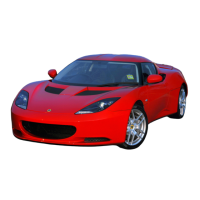Page 12
Lotus Service Notes Section BU
RH side: - Engine radiator return pipe
- A.C. feed and return pipes
- PAS feed and return pipes
- Right hand rear brake pipe
LH side: - Engine radiator feed pipe
- Heater feed and return pipes
- Clutch pipe
- Brake servo vacuum pipe
- Positive battery cable to front post.
Check also, by comparison with the displaced part, that the 'B' post reinforcement panel, and all neces-
sary bonded brackets and captive fixings, are correctly attached to the new sill panel.
8. Prepare the bonding surface of the new body side panel with Betaclean 3900 and Betaprime 5404 (see
sub section BU.5). Prepare surface of the old adhesive bead on the chassis and body panels Using Betaw-
ipe 4000 (see sub-section BU.5).
9. Apply a bead of Betaseal adhesive (see sub-section BU.5) to the bonding surface on the chassis, windscreen
frame and rear bulkhead, and fit the body side panel into position, first locating the sill bottom edge into
its chassis slot. Press all around the joint and ensure sufficient spread of adhesive, if necessary using a
spatula to smooth or remove any extruded adhesive, and to neaten any visual areas. Where necessary,
add adhesive to the jointline to ensure complete weathersealing and neat appearance, especially around
the door hinge post apertures, and smooth with a spatula.
10. Clamp the panel into position until the adhesive has cured (see sub-section BU.5).
11. Refit the dash panel, front and rear clamshells, doors, both wheelarch liners and other components as
necessary.
BU.10 - REAR BULKHEAD
The rear bulkhead is a Resin Transfer Moulded (RTM) panel and is bonded to the chassis and seat belt
mounting frame. The roof panel is bonded to its top flange, and the body side panels to each side flange.
A heat formed polyester fibre heat/acoustic insulator panel is bonded to the rear side of the panel. The
cabin rear window is bonded directly to the bulkhead using the same materials and procedure as is used for
the windscreen. A screw fixed panel is provided on the right hand side to allow access from the cabin to the
alternator, compressor and adjacent engine components.
Replacement of the complete bulkhead panel is unlikely to be required without a complete body rebuild.
In the case of localised damage, the panel should be repaired in situ using conventional hand lay techniques,
if necessary integrating a new section cut from a new bulkhead panel. The position of th e rear bulkhead is
critical to the fit of the tailgate and rear body section. If building up a new chassis tub, a jig assembled bulkhead
and rear seat belt mounting frame should be used, as a 3 - 5 mm standoff is required between the panel and
frame.
Rear Window: In order to minimise noise and heat transmission into the cabin, the rear bulkhead window is a
double glazed unit comprising two 4mm, toughened, clear, flat glass panes, separated by a 6mm void filled with
Argon gas. An obscuration band is applied to the rear face of both panes, with identification data read from
the engine bay side. The unit is bonded to the front face of the rear bulkhead panel using materials supplied
by Dow Chemical.
To replace the glass, remove the rear bulkhead trim and use a reciprocating knife to cut the bonding
medium. Clean the whole of the bonding surface on the new glass with Betawipe VP 04604 (yellow cap), and
prime with Betaprime 5500 (green cap). Clean the corresponding surface on the bulkhead with Betaclean 3900
(black cap) and prime with Betaprime 5404 (red cap). Apply a bead of Betaseal 1701 to the periphery of the
glass, and press into position on the bulkhead to ensure sufficient and uniform compression of the adhesive.
Use a spatula to remove excess extruded adhesive and smooth any visual areas. Support the glass in place
as necessary until the adhesive has cured suffiently.

